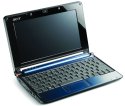Mini-notebook shipments up sharply
Aug 13, 2008 — by Eric Brown — from the LinuxDevices Archive — views A Gartner study estimates 5.2 million mini-notebooks will ship this year, rising to 8 million units in 2009. Gartner pegs Linux and Windows XP as the two dominant operating systems (OSes) in the segment, which could hit 50 million shipments annually by 2012, says Gartner.
A Gartner study estimates 5.2 million mini-notebooks will ship this year, rising to 8 million units in 2009. Gartner pegs Linux and Windows XP as the two dominant operating systems (OSes) in the segment, which could hit 50 million shipments annually by 2012, says Gartner.
In “Dataquest Insight: Forecast Scenarios for Mini-notebooks, Worldwide,” Gartner defines mini-notebooks as having a screen size of 5 to 10 inches, similar to the general definition being bandied about for the “netbook” category. The netbook-like mini-notebooks are further defined as running a full client OS, and as being larger than the 3-5-inch display MIDs, which Gartner refers to as “micro-information devices.”
By most accounts, the netbook/mini-notebook category has been booming lately. A recent study by Market Intelligence Center (MIC) of Taiwan predicted that global shipments of “low-price mini notebooks” will reach 8.02 million units in 2008 and 18.3 million units in 2009, with a near-term volume growth of 128 percent annually. The segment has been dominated by the Asus Eee PC (pictured at top) until recently, said MIC. However, consumers now have an increasing variety of name-brand netbooks from which to choose.



Asus EEE 901, MSI Wind NB U100, and Acer Aspire One
(Click any for details)
According to MIC, Windows XP has the edge over Linux in the category. Yet, it appears from anecdotal evidence that Linux market share is larger than it has been for other laptop and desktop categories. Its strong presence in the category is perhaps due to the fact that Linux netbooks often have a slightly lower pricetag than similar Windows XP versions, especially when open source software is factored in. Also, Apple has yet to enter the market, and the Vista-focused Microsoft appears to have been temporarily caught off guard by the success of systems too low-powered to run Vista.
In addition, Linux was arguably the pioneer of the segment. Gartner did not release a breakdown of OS share for the mini-notebook segment, but it did note that the category began with “low-cost education PCs,” no doubt referring to the One Laptop per Child (OLPC) XO. The XO began as a Linux-based system, and has also recently gained a Windows XP option (though the early builds of XO XP have garnered poor reviews).
New rules for the notebook business
Since the end of 2007, the audience has expanded to “consumers in both mature and emerging markets and a few business buyers,” says Gartner. Consumers will eventually account for about 70 percent of mini notebooks, says the study, with key adoption drivers including market positioning, device price, availability and cost of wireless connectivity, and support from channel partners and retailers.
Stated Annette Jump, research director at Gartner, demand for the minis will be driven by “their small form factor and small screen, their light weight, their price, their ease of use and their basic, but sufficient, PC functionality.”
Jump went on to say, “Potential users are likely to include both first-time buyers seeking a low-cost introductory PC as well as experienced users seeking a low-cost second or third PC for themselves or a relative.”
Vendors of traditional business-oriented notebooks will need to make adjustments for the new consumer audience, says Jump. “PC vendors will need to pay increasing attention to the design and ease of use of mini-notebooks,” she says. “These will be two crucial factors in this segment.”
PC vendors may also need to adjust their channel strategies, Jump says, “and possibly look for new channels, such as telecom, gadget shops, and so on.”
Availability
The study, called “Dataquest Insight: Forecast Scenarios for Mini-notebooks, Worldwide,” is available for registered subscribers here.
For a guide to Linux netbooks, see our regularly updated Linux Netbooks Showcase.
This article was originally published on LinuxDevices.com and has been donated to the open source community by QuinStreet Inc. Please visit LinuxToday.com for up-to-date news and articles about Linux and open source.